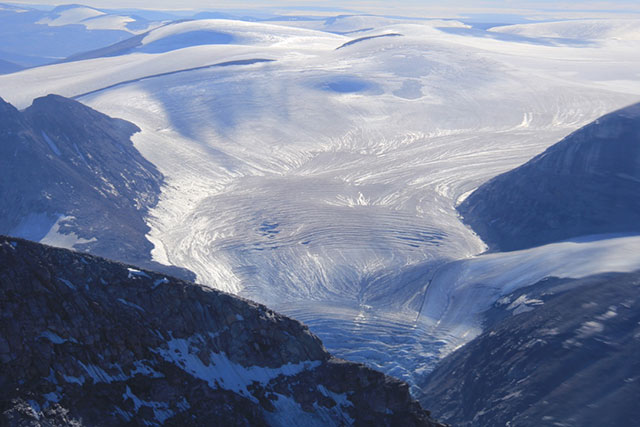
The Inuit in the Canadian Arctic are engaged in a centuries-old fight to retain their culture and reestablish self-determination and genuine sovereignty. In particular, Inuit in the autonomous territory of Nunavut are resisting what American Indian studies scholar Daniel R. Wildcat has described as a “fourth removal attempt” of Indigenous people, coming on the heels of failed efforts at spatial, social and psycho-cultural deletion.
The common discourse on climate change focuses on the physical world: inexorably rising atmospheric concentrations of carbon dioxide and the impact on sea-ice extent; melting glaciers; and roiling, unpredictable perturbations in weather patterns. But these are but the physical manifestations of political decisions made in the social world. The questions behind them include: Who produced all that extra CO2? For what purposes? And which sets of people are paying the most immediate price?
In both realms, the Arctic, one of the regions least responsible for causing climate change, is bearing the most immediate brunt; though as Inuit activist, Nobel Prize nominee and author Sheila Watt-Cloutier warns in her book, The Right to Be Cold, “whatever happens in the poles will eventually happen everywhere else.”
To frame climate change in the Arctic as simply a story of liquefying dihydrogen monoxide is deceptive. The ice-filled north is first and foremost a human story, a story about home and the struggle to preserve it against outside forces. It is about a culture that quite literally rests on knowledge of ice, ocean and the animals that live on top and underneath it.
James Qillaq, mayor of Clyde River in Nunavut, explained, “That connection to the land, that’s our life … that’s the reason why we stand: our connection to the land and water, of something that is ours, that’s it. That’s it and nothing else. That’s our everything — our connection to the land.”
Jerry Natanine, also of Clyde River, added, “Different animals are hunted in different seasons. We follow the young seals when they go out, to go hunt them, fishing season when the fish are plentiful. There’s a time when the Arctic char smell like what they eat in the ocean — that’s when some people don’t like to eat them. When that’s over, berry-picking season.”
With over 80 different terms to describe various aspects and characteristics of sea ice, the life of Inuit in Clyde River is intimately connected to the reliable variability and cycles of sea ice. In her book, The Meaning of Ice, scientist and longtime resident of Clyde River Shari Fox Gearheard notes: “The cycle of sea ice is bonded to cycles of hunting, of family activities, of equipment preparation, and even of cravings for different foods.”
But as Jerry Natanine notes, things have changed. “Maybe one of the biggest changes would be old ice,” he told me. “There used to be old ice that was really thick, and that would be out in the coast, and it would protect our inlets from waves…. But now ice comes out faster and the waves come in sooner … springtime seal hunting hasn’t been as good as it used to be. In James’s day, like my parents’ day, they hardly ever worried about [thin ice]. There might be an open water here or there, but now we worry about it even more.”
Climate Change and Arctic Amplification
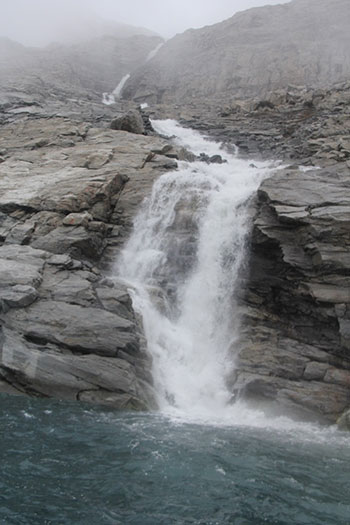 One of many waterfalls cascades down the vertical cliffs of Sam Ford Fiord, testament to the volume of glacier melt. (Photo: Chris Williams)The most recent displacement attempt against Inuit is related to the fact that the Arctic is warming at twice the rate of lower latitudes. Over the last five decades, sea ice has vanished from an area twice the size of Alaska. The remaining ice is 50 percent thinner. The last nine years have all had the lowest sea-ice extents measured, with February 2015 showing the lowest in 37 years of satellite data. Over 50 percent of the gigantic ice sheet that blankets Greenland was melting during the summer of 2015, contributing to the 36th consecutive year of global glacier loss.
One of many waterfalls cascades down the vertical cliffs of Sam Ford Fiord, testament to the volume of glacier melt. (Photo: Chris Williams)The most recent displacement attempt against Inuit is related to the fact that the Arctic is warming at twice the rate of lower latitudes. Over the last five decades, sea ice has vanished from an area twice the size of Alaska. The remaining ice is 50 percent thinner. The last nine years have all had the lowest sea-ice extents measured, with February 2015 showing the lowest in 37 years of satellite data. Over 50 percent of the gigantic ice sheet that blankets Greenland was melting during the summer of 2015, contributing to the 36th consecutive year of global glacier loss.
Going further back in time, recent research based on a compendium of historical data shows, “there is no point in the past 150 years where sea ice extent is as small as it has been in recent years,” whereby the rate of retreat is “unprecedented in the historical record.” Commenting on the study, climate scientist and director of the NASA Goddard Institute for Space Studies, Gavin Schmidt confirmed: “From this work it’s clear that recent changes are enormously outside the bounds of natural variability over the historical period.”
To observe some of these changes — and in response to an invitation to supply the Inuit community of Clyde River with solar panels for their community hall — in August, the Greenpeace vessel Arctic Sunrise sailed from St. Johns, Newfoundland, with a hold full of solar panels. Along with activists and Greenpeace campaigners, on board the ship were the current mayor of Clyde River, James Qillaq and former mayor Jerry Natanine and his daughter Clara. All of them have been actively campaigning against the Canadian government’s approval of seismic blasting in Baffin Bay, where they hunt. As we sail further north, deeper into the Canadian Arctic on the voyage to Clyde River, Schmidt’s chilling prediction, “under continued emissions we are likely to see summer ice … effectively disappear over the next few decades,” is borne out by our observations from the deck of the Sunrise: The scantiness of thinning patches of sea-ice tells its own story. As if to emphasize the paucity of sea ice, giant tabular bergs, some several stories high, float by us on their journey from Greenland toward the Canadian Coast. A startlingly beautiful combination of blinding white and translucent electric blue against the dark backdrop of sea and sky, the bergs are bobbing, melting reminders of ever-decreasing land-based glaciers.
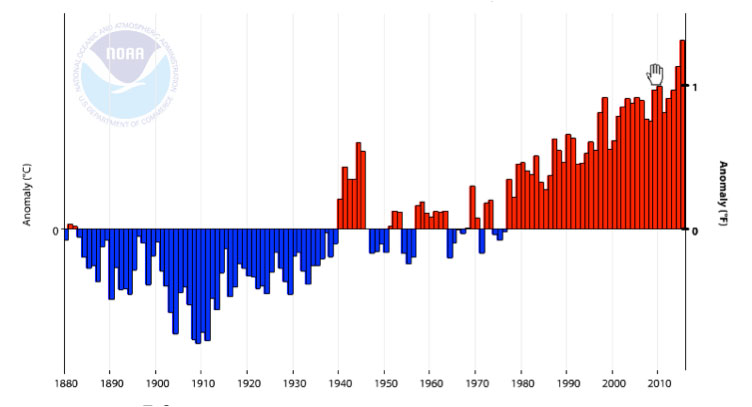 Annual Global Sea Surface Temperature Anomalies, 1880-2016. (Credit: NOAA National Centers for Environmental information, Climate at a Glance: Global Time Series, published August 2016.)
Annual Global Sea Surface Temperature Anomalies, 1880-2016. (Credit: NOAA National Centers for Environmental information, Climate at a Glance: Global Time Series, published August 2016.)
Record heat in the first half of 2016 edged the world to within touching distance of the 1.5C maximal limit declared dangerous by world leaders in Paris just six months earlier, when 192 countries agreed that the limit should not be breached. With land and sea temperatures averaging 1.3C higher than the 20th century average, the UN observed in July, “Arctic sea ice melted early and fast … June 2016 marked the 14th consecutive month of record heat for land and oceans. It marked the 378th consecutive month with temperatures above the 20th century average. The last month with temperatures below the 20th century average was December 1984.” [emphasis added].
 Icebergs float in Baffin Bay, but very little sea ice is present. (Photo: Chris Williams)
Icebergs float in Baffin Bay, but very little sea ice is present. (Photo: Chris Williams)
Climate Change, Capitalism and Inuit Livelihoods
For Inuit, Arctic climatic change imposed by a social system based on profit and endless commodification represents a double threat to their culture. In a 2006 survey of attitudes toward further commodification and paid employment versus traditional hunting and gathering practices, 75 percent of Inuit in Nunavut wanted to retain a mix of subsistence and wage work, only 15 percent responding said they wanted to work solely for money. This is an unsurprising statistic when 80 percent of people obtain the majority of their meat and fish from subsistence hunting and 96 percent share food with other households, according to John Talberth and Daphne Wysham’s report “Beyond Fossil Fuels.” Whenever there is a successful hunt, news spreads instantly via radio. All households, including those in other communities, have the opportunity to share in the skill and good fortune of the hunting party.
Illustrative of conflicting value systems, even though affordable quality housing is in desperate short supply, in 2016 the people of Nunavut voted overwhelmingly to prevent the sale and privatization of municipal property, allowing them to retain collective control over their own land. Housing is not the only thing in short supply. The following quote is from a report prepared for the Nunavut Roundtable for Poverty Reduction, “Understanding Poverty in Nunavut”:
The Income Support Program in Nunavut exists to help those unable to access a minimum standard of living. In Nunavut, half of the population needs this help for at least a portion of the year, and almost 60 percent of the population lives in public housing. Nearly 70 percent of Nunavut’s children live in households rated as food insecure and 15 percent of children will experience at least one day in the year when they do not eat. In Nunavut, poverty is not a fringe or special interest issue. It is the issue.
According to the Greenpeace-commissioned report on eastern Nunavut, “Beyond Fossil Fuels” and confirmed elsewhere, the median wage for Inuit is $19,900 (Canadian), while for non-Inuit living in Nunavut it is a staggeringly disparate $86,600. As the authors of the Greenpeace-commissioned report comment, “The irony is that poverty is, in many ways, a product of the formal market economy. In the indigenous economy, financial insecurity, food insecurity and substandard housing did not exist.”
As history bears out, is it any wonder that Nunavummiut are skeptical of the much-touted benefits of the market? The decline of Inuit living standards with the advance of colonialism and the increasing intrusion of market economics into Inuit life is attested to in the journal entries of Sir William Edward Parry, the British naval officer, arctic explorer and hydrographer who visited Clyde River almost 200 years ago. In September 1820, Parry wrote:
To judge by their appearance, and what is perhaps a better criterion, the number of their children, there can be little doubt that the means of subsistence which they possess are very abundant; but of this we had more direct proof, by the quantity of sea-horses and seals which we found concealed under stones, along the shore of the north branch…. Upon the whole, these people may be considered to be in possession of every necessary of life, as well as of most of the comforts and conveniences which can be enjoyed here.
Today, extreme corporate profiteering exacerbates the poverty and inequality in Clyde River. The cost of basic necessities is grossly higher than in southern Canada. Like many communities in the north, the only store in town is operated by the Northern multinational grocery and retail corporation, part of the North West company headquartered in Winnipeg, Manitoba. In a direct link to Canada’s colonial history, North West traces its origins back to colonial fur trading. It was formerly the Hudson’s Bay Company, which started its fur business in British-controlled North America in the latter half of the 1700s.
Prices in Northern’s store in Clyde River are shocking: a single can of Coke is $6.15; 12 rolls of toilet paper are $12.99; a pack of 38 diapers is $30.99. According to people living in Clyde, the prices we saw in the supermarket will rise higher as September approaches, in anticipation of the arrival of the once-yearly supply ship.
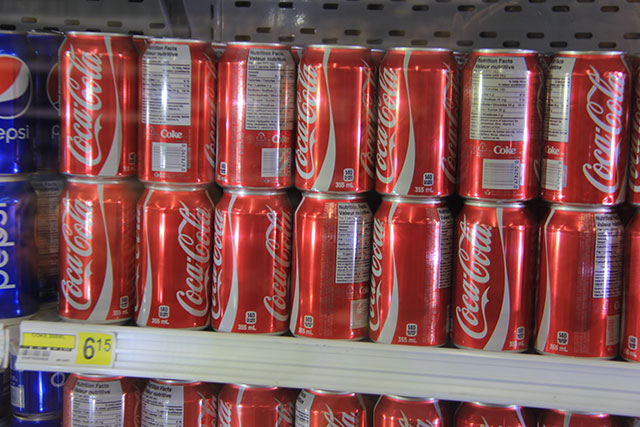 Price of a can of coke is $6.15 (Canadian) in the Northern Store, the only shop in Clyde River. (Photo: Chris Williams)
Price of a can of coke is $6.15 (Canadian) in the Northern Store, the only shop in Clyde River. (Photo: Chris Williams)
Such disparity in price for everyday items is symptomatic of the racism, exploitation and neglect condoned and perpetuated by the Canadian state. As Native-American scholar and professor of law, Robert A. Williams Jr. wrote in Savage Anxieties, “Canada is one of the world’s most prosperous countries, yet its record in protecting the most basic human rights of Indigenous tribal peoples has been abysmal. … Major organs of the United Nations have recognized the critical relationship between First Nations’ poverty in Canada and the state’s failure to protect traditional lands, territories, and resources from environmentally destructive development.”
Indigenous Activism and UNDRIP
But such failure is far from unique. It has taken decades of relentless campaigning by Indigenous groups to force the international community to recognize rights to their historical lands. Finally, seven years into the 21st century, the United Nations put forward the UN Declaration on the Rights of Indigenous People (UNDRIP) for the world’s governments to adopt and sign. At the signing ceremony in September 2007 however, Canada was one of only four countries in the entire General Assembly to vote against adoption of UNDRIP. The other countries: the United States, New Zealand and Australia. To maintain legitimacy, these four colonial settler states must deny not only their despotic, racist and genocidal origins, but also the continuance of neocolonial policies that refuse to accept the primacy of Indigenous land sovereignty. Neocolonial policies directed against Indigenous land sovereignty continue today, as shown by an Inuit case being brought before the Supreme Court of Canada on November 30 against seismic blasting in Baffin Bay in search of oil and gas deposits, legal support for which is being provided by Greenpeace. The continuation of these policies is also evident in the struggle against the Dakota Access pipeline by Native Americans from the Standing Rock Sioux Reservation, North Dakota and more than 100 other tribes from across North America. Historian and Native-American scholar Roxanne Dunbar-Ortiz writes in An Indigenous People’s History of the United States:
The form of colonialism that Indigenous peoples of North America have experienced was modern from the beginning: the expansion of European corporations, backed by government armies, into foreign areas, with the subsequent expropriation of lands and resources. Settler colonialism is a genocidal policy. … The early twenty-first century has seen increased exploitation of energy resources begetting new pressures on indigenous lands. … Strengthening Indigenous sovereignty and self-determination to prevent [renewed expropriation of land and resources] will take general public outrage and demand, which in turn will require that the general population, those descended from settlers and immigrants, know their history and assume responsibility.
Specifically, Article 32 of UNDRIP notes, “States shall consult and cooperate in good faith with the Indigenous peoples concerned through their own representative institutions in order to obtain their free and informed consent prior to the approval of any project affecting their lands or territories and other resources, particularly in connection with the development.”
The key phrase in Article 32, “prior and informed consent,” changes everything about Clyde River’s legal standing in their impending case before the Canadian Supreme Court. If acted upon, consultation with Inuit and all other Indigenous groups has to be genuine on any issue that pertains to their “land and territories,” and projects cannot move forward without their “informed consent.” The question is whether Canada will be legally or morally bound to uphold UNDRIP, a declaration it unapologetically refused to adopt in 2007, but which Prime Minister Trudeau has since signed on to this year.
For its part, the United States changed its position with respect to UNDRIP in 2010, when President Obama said the US would “lend its support” to the declaration. However, in a subsequent statement, the federal government made it clear that UNDRIP should not be taken as “legally binding or a statement of current international law.”
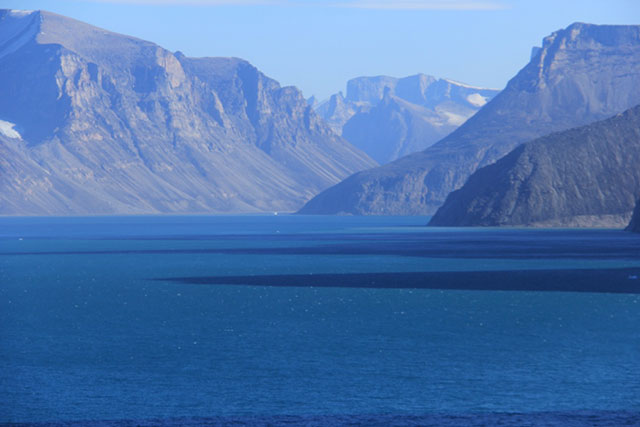 The sublime majesty and otherworldly grandeur of Baffin Island. Note the lack of glaciated land. (Photo: Chris Williams)
The sublime majesty and otherworldly grandeur of Baffin Island. Note the lack of glaciated land. (Photo: Chris Williams)
A Melting Arctic Brings New Threats and Reignites Resistance
In new challenges to Indigenous rights, the melting Arctic is fostering and aggravating geopolitical concerns. Under pressure from the rise of Indigenous protest movements across North America, President Obama and Prime Minister Trudeau issued a joint statement in March 2016, in which they ratcheted up the rhetoric of consultation with Indigenous peoples over development decisions. Framed as a major statement on action to protect the Arctic from climate change while developing energy and US-Canadian leadership, the two world leaders stated, “Canada and the US will continue to respect and promote the rights of Indigenous peoples in all climate change decision making.”
In a section on building a “sustainable Arctic economy” that is impossible to reconcile with the actions of their respective governments, Trudeau and Obama write, “We confirm that for commercial activities in the Arctic — including shipping, fishing, and oil and gas exploration and development — we will set a world-class standard by basing development decisions and operations on scientific evidence. Further, commercial activities will occur only when the highest safety and environmental standards are met, including national and global climate and environmental goals, and Indigenous rights and agreements.”
Yet, in the same month, a letter signed by 75 marine scientists was presented to President Obama, expressing concern about the US Interior Department’s proposal and approval for more seismic testing in the Atlantic. This concern is of direct relevance to Inuit who are fighting proposed seismic blasting in Baffin Bay. The scientist noted, “Airgun surveys [seismic blasting] have an enormous environmental footprint. For blue and other endangered great whales, for example, such surveys have been shown to disrupt activities essential to foraging and reproduction over vast ocean areas.” No stranger to the gap between words and deeds, President Obama came under fire again in August for authorizing more oil and gas leases in the Gulf of Mexico and the need for more seismic blasting.
President Obama’s approval for the leases came despite an open letter addressed to him in June, signed by a different group of 400 international Arctic, marine and climate scientists. The letter argued that the president should say no to new leasing or exploration in the Arctic and engage in better and fuller consultation with Arctic communities:
We, the undersigned, ask you to remove the two Arctic planning areas, which together comprise nearly the entire U.S. Chukchi and Beaufort seas, from the 2017–2022 Outer Continental Shelf Leasing Program. We further ask that you consult with indigenous communities and tribes, who have extensive traditional knowledge relevant to decision- making, and with Arctic scientists to identify and permanently withdraw additional important marine areas to promote a sustainable, resilient future for this extraordinary ecosystem.
US-Canadian Plans for Arctic Imperialism
One only needs to read the financial press to obtain statistics undermining any claim by the Obama administration to have environmental credentials or to take climate change seriously. As reported this year in Forbes, “The irony is that President Obama — who is not viewed as a friend of the oil and gas industry — has presided over rising oil production in each of the seven years he has been in office. … From that low point in 2008, U.S. oil production has grown each year to reach 9.4 million bpd in 2015 — a gain of 88 percent during Obama’s presidency. This is in fact the largest domestic oil production increase during any presidency in U.S. history.”
Presaging the melting of summer sea ice, writing in Foreign Affairs in 2013, Scott Borgerson excitedly noted in “The Coming Arctic Boom” that global warming is a reality that doesn’t have to be “all bad”:
In the Arctic, it is turning … an impassible body of water ringed by remote wilderness into … an epicenter of industry and trade akin to the Mediterranean Sea. The region’s melting ice and thawing frontier are yielding access to troves of natural resources, undiscovered oil and gas and massive deposits of valuable minerals … a central passageway for global maritime transportation.
Colonialism may have altered its methods in response to the resistance of colonized peoples across the world, but the aims remain the same. Rather than driving Inuit off the land, the US and Canada in the 21st century want to ensure Indigenous people continue to live in the Arctic, but do so without genuine sovereignty and decision-making power over how energy is produced. In this regard, one phrase in the Obama-Trudeau statement is telling. They write, “All Indigenous Peoples in the Arctic are vital to strengthening and supporting U.S. and Canadian sovereignty claims.” Which is to say, Indigenous people living in the Arctic and recognized as “American” or “Canadian” are central to cementing North American control over the region and dispelling the US and Canadian government’s geopolitical and military concerns with any Russian and Norwegian claims to offshore resources and mining rights. As noted in a July report to Congress by the US Department of Defense alluding to such concerns, as well as the increased risk of catastrophic environmental disasters and the immediate problem of climate change:
North American Aerospace Defense Command / U.S. Northern Command (NORAD/USNORTHCOM) and USEUCOM are concerned with security risks arising from increased shipping, military operations, and resource exploration in the Arctic as the ice-cap melts. … USNORTHCOM identifies increased resource exploration in the Arctic as driving an increase in the future demand for SAR (Search and Rescue) and environmental disaster response missions in support of other agencies and civil authorities.
The fears of the US military reinforce the fact that successfully resisting additional depredations of climate change in the Arctic and elsewhere means connecting this resistance to the overthrow of neocolonial policies promulgated by the United States and Canada. Former mayor of Clyde River Jerry Natanine, a staunch campaigner for Inuit rights and a fellow traveler on the Arctic Sunrise, sees it in precisely those terms:
As Inuit we feel we have the right to our territories. Even though our Land Claims Agreement with Canada states that our agreement only goes out twelve miles offshore but our animals we hunt, they cannot tell where that twelve mile is. …We feel that these waters are our waters, as a nation, as human beings that are living on the earth and we’ve lived in this area for thousands and thousands of years … Let’s say we want to drill for oil — that should be our choice, not anyone else’s. People shouldn’t come barging in and try to take over our land for mining or oiling and just extract the resources to take away. As Inuit we don’t want to be neglected when these decisions are being made because it’s our land that they’re dealing with, it’s not anybody else’s land because Inuit live here.
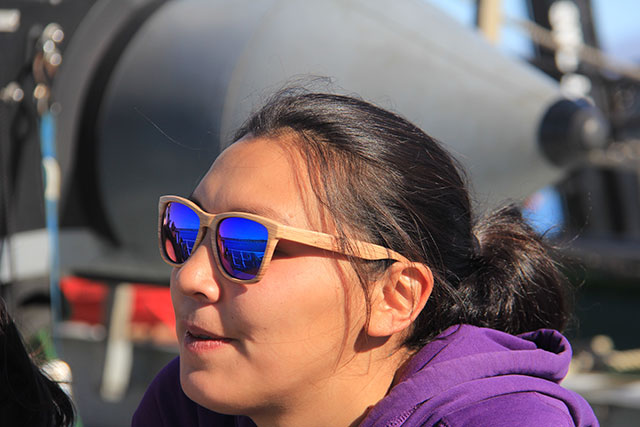 Clara Natanine, daughter of Jerry and a vocal opponent of seismic blasting because of the threat it poses to the home she loves. (Photo: Chris Williams)
Clara Natanine, daughter of Jerry and a vocal opponent of seismic blasting because of the threat it poses to the home she loves. (Photo: Chris Williams)
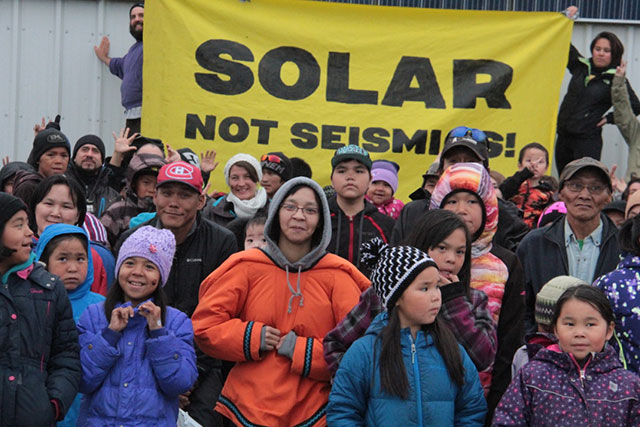 The overwhelming majority of Clyde River residents turn out to show their support for the future they want and to oppose Seismic Blasting. (Photo: Chris Williams)
The overwhelming majority of Clyde River residents turn out to show their support for the future they want and to oppose Seismic Blasting. (Photo: Chris Williams)
For those of us further south, effective resistance to climate change requires blanket opposition to US and Canadian imperial designs and neocolonial, racist policies. It means supporting the geographical rearrangement of North America to repatriate land and resources to the original inhabitants from whom it was stolen, taking genuine responsibility for history and fighting against ongoing crimes that serve and expand colonial profit and power.
Join us in defending the truth before it’s too late
The future of independent journalism is uncertain, and the consequences of losing it are too grave to ignore. To ensure Truthout remains safe, strong, and free, we need to raise $27,000 in the next 24 hours. Every dollar raised goes directly toward the costs of producing news you can trust.
Please give what you can — because by supporting us with a tax-deductible donation, you’re not just preserving a source of news, you’re helping to safeguard what’s left of our democracy.